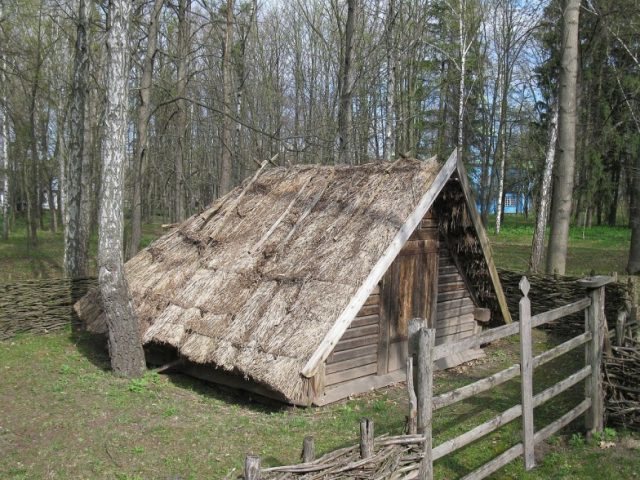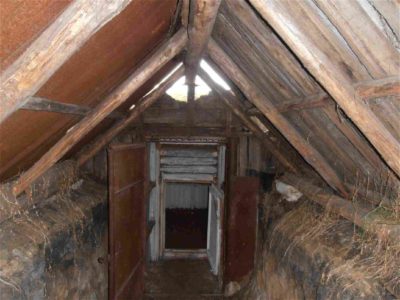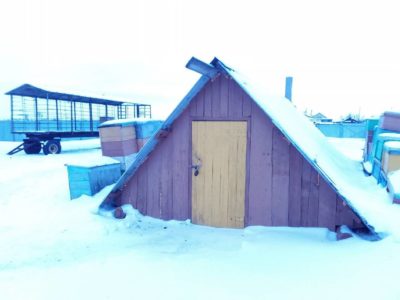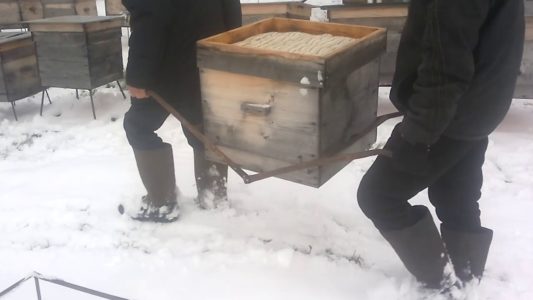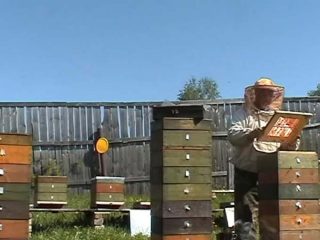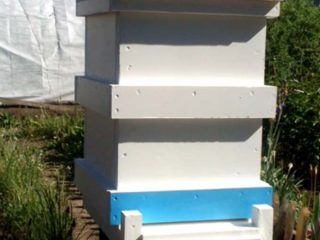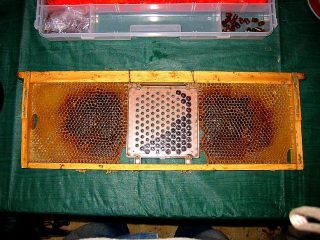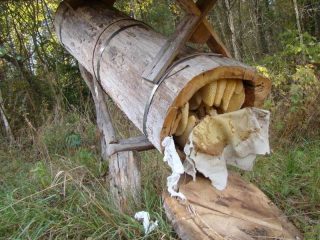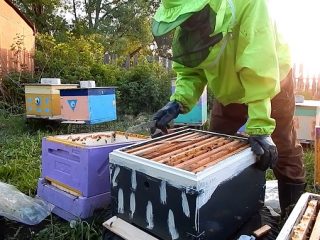Content
Omshanik resembles a barn, but differs in its internal structure. In order for the wintering of bees to be successful, the building must be properly equipped. There are options for Omshaniks that look more like a cellar or a basement partially buried in the ground. Every beekeeper can build a winter house for bees of any design.
What is Omshanik
To give a precise definition, Omshanik is an insulated farm building, equipped for a winter storage of hives with bees. During the entire cold period, the beekeeper visits the winter house a maximum of 4 times. The visit is connected with a sanitary examination. The beekeeper checks the hives, looks for rodents, mold on the houses.
Winter houses are usually small. The internal space should be sufficient to accommodate the bee hives and a small passageway for the beekeeper to carry out the inspection. For example, the size of Omshanik for 30 bee families reaches 18 m2... The height of the ceiling is made up to 2.5 m.To reduce the area, the hive can be placed in tiers, for this, racks, shelves, and other devices are equipped inside the building. In summer, the winter house is empty. It is used in place of a barn or storage.
What are the winter houses
According to the type of installation, there are three types of omshanik for bees:
- A ground-based wintering house resembles an ordinary barn... The building is often erected by novice beekeepers who are not confident in the further development of their business. The construction of an aboveground winter house is less laborious and requires a small investment. With all efforts to insulate the storage, in severe frosts it will have to be heated.
- Experienced beekeepers prefer underground winter huts... The building resembles a large cellar. The construction of the winter house is laborious, since it is necessary to dig a deep foundation pit. You will have to hire earth-moving equipment, which entails additional costs. However, inside the underground Omshanik the above-zero temperature is constantly maintained. Even in severe frosts, it does not need to be heated.
- Combined hibernation for bees combines two previous designs... The building resembles a semi-basement, buried in the ground along the windows to a depth of 1.5 m. The combined winter house is placed on a site where there is a threat of flooding by groundwater. It is more convenient to enter the partially recessed basement due to the fewer steps. The presence of windows provides the interior space with natural light, but at the same time, heat loss increases.
If an underground or combined type of Omshanik is chosen for construction, the location of the groundwater is calculated not to the surface of the earth, but to the floor level. The indicator should be at least 1 m. Otherwise, there is a threat of flooding. Inside the winter house there will be constant dampness, which is harmful to bees.
Requirements for Omshanik
To build a good Omshanik with your own hands, you need to know the requirements for the construction:
- The size of the bee storage should correspond to the number of hives. The houses are neatly arranged. If multi-tiered storage of hives is envisaged, racks are made. Additionally, they are thinking about the future expansion of the apiary.So that later you do not have to finish building the winter house, it is immediately made large. The spare space is temporarily partitioned off to reduce heat loss. It is optimal for single-wall hives to allocate about 0.6 m3 premises. At least 1 m is allocated for double-walled sun loungers3 space. It is impossible to underestimate the size of the storage for bees. In cramped conditions, it is inconvenient to service the hives. Extra space will lead to large heat losses.
- The roof must be made with a slope so that precipitation does not accumulate. Slate, roofing material are used as roofing material. The roof is insulated with natural materials to the maximum: straw, reeds. If the winter house is located near the forest, the roof can be covered with spruce branches.
- The entrance is usually done alone. Heat loss will increase through additional doors. Two entrances are made in a large Omshanik, where more than 300 hives with bees will spend the winter.
- In addition to the roof, all structural elements of the Omshanik are insulated, especially, this applies to the above-ground and combined winter house. To make the bees feel comfortable in frost, the walls are insulated with foam or mineral wool. The floor is laid from a board, raised by logs from the ground by 20 cm.
- There will be enough natural lighting for the combined and aboveground winter house through the windows. A cable is laid in the underground Omshanik for bees, a lantern is hung. Strong lighting is not necessary for bees. 1 light bulb is enough, but it is needed more by the beekeeper.
- Ventilation is a must. Dampness accumulates inside the winter house, which is harmful to bees. The humidity level is especially high in the underground storage. Natural ventilation is equipped with air ducts installed at different ends of Omshanik.
If all requirements are met, an optimal microclimate for bees will be maintained inside the winter house.
What temperature should be in Omshanik in winter
Inside the winter house, the bees must constantly maintain a positive temperature. Optimal score + 5 aboutC. If the thermometer drops below, artificial heating of the bees is arranged.
How to build an aboveground bee omshanik
The easiest option for a winter house is a ground-type building. Most often, ready-made structures are adapted. They make Omshanik from a greenhouse, a shed, an apiary shed. With the onset of heat, the hives with bees are taken out, and the building is used for its intended purpose.
If there is no empty structure on the site, they begin to build a winter house. Collect overground omshanik from wood. Natural material is a good insulation material, which eliminates the need for additional layers of thermal insulation.
For Omshanik, a dry area not flooded with sewage is chosen. It is advisable to find a place protected from drafts. The foundation of the winter house is made of pillars. They are dug in to a depth of 80 cm in 1-1.5 m increments. The pillars rise 20 cm above ground level and are located in the same plane.
A frame made of timber is laid out on the foundation, logs are nailed in 60 cm steps, the floor is laid from the board. It turns out a wooden platform in the form of a large shield. The racks of the frame of the winter house and the upper harness are similarly made of timber. Immediately provide for the location of windows and doors in Omshanik for bees. The frame is covered with a board. The roof is easier to make a pitched roof. You can try to build a gable roof of the winter house, then the attic space can be used to store beekeeping equipment.
How to build an underground Omshanik
The most insulated room for wintering bees is considered to be of the underground type. However, it is difficult and expensive to build it. The main difficulty lies in digging a foundation pit and erecting walls.
For underground Omshanik, a site with deep groundwater is chosen. Preference is given to elevations so that the basement is not flooded with rain and during the melting of snow. A pit is dug 2.5 m deep. The width and length depend on the number of hives with bees.
The bottom of the pit is leveled, tamped, covered with a pillow of sand and gravel. A reinforcing mesh is laid on brick stands, poured with concrete. The solution is allowed to harden for about a week. One of the walls of the pit is cut off at an angle, and the entry point is arranged. In the future, steps are laid out here.
The walls of omshanik for bees are laid out of bricks, cinder blocks, or cast monolithic from concrete. In the latter version, it will be necessary to erect formwork around the perimeter of the pit, to mount a reinforcing frame made of rods. Before erecting the walls of the winter house from any material, the walls of the pit are covered with roofing material. The material will serve as waterproofing, protect Omshanik from moisture penetration. Simultaneously with the erection of the walls, the steps of the winter house are arranged. They can also be poured out of concrete or laid out with a cinder block.
When the walls of Omshanik are completed, they create a roof frame. It should protrude slightly from the ground, and it is made on a slope. For the frame, a bar or a metal pipe is used. Sheathing is carried out with a board. From above, the roof is covered with roofing material. You can additionally lay slate. For insulation, reeds and spruce branches are thrown on top.
To arrange ventilation in the roof, holes are cut from opposite sides of the Omshanik. The air ducts are inserted from a plastic pipe, and protective caps are put on from above. When the winter house for the bees is built with their own hands, they begin the internal arrangement: they lay the floor, install racks, and carry out lighting.
How to build a semi-underground Omshanik with your own hands
A combined wintering house for bees is erected similarly to the underground Omshanik. The depth of the pit is dug about 1.5 m. The walls are driven out of concrete, brick or cinder block to ground level. Above, you can continue construction from a similar material or install a wooden frame. A simpler option is based on the assembly of a frame from a bar and sheathing with a board according to the principle of aboveground construction. The roof of the winter house is equipped with a single-slope or gable as you wish.
Important nuances when building a winter road
For the wintering of bees in Omshanik to be successful, it is necessary to create a favorable microclimate. You can achieve good results if you properly insulate the building, organize ventilation, heating.
How to make ventilation in Omshanik
The bees hibernate in the club, and the union occurs when the thermometer's thermometer drops below + 8 aboutC. Insects inside the hive heat themselves. Bees generate heat due to the breakdown of sugars from consumed feedings. However, carbon dioxide is released along with the heat. Its concentration can reach 3%. In addition, with the breath of the bees, steam is released, which increases the level of humidity. Excess carbon dioxide and steam are harmful to insects.
The bees are quite wise and in the hives they independently equip the ventilation. The insects leave the right amount of holes. A portion of fresh air enters the bees through the vents inside the hives. Carbon dioxide and steam are discharged outside and accumulate in Omshanik. At a high concentration, bees weaken, consume a lot of food. Insects become restless due to the upset of the digestive system.
The removal of moisture with carbon dioxide is organized through a ventilation system. It is optimal to make it adjustable with dampers. In large Omshanik, it is optimal to equip the hood with a fan. To draw out only dirty air located under the ceiling, a screen is attached under the air duct.
The most popular ventilation system for bees in Omshan is the supply and exhaust system. The winter house is equipped with two air ducts located in opposite parts of the room. The pipes are led out into the street. The hood is cut off at the ceiling, leaving a 20 cm protrusion.The supply pipe is lowered to the floor, leaving a gap of 30 cm.
The simplest ventilation scheme is one pipe, brought out to the street and cut off under the ceiling inside Omshanik. However, the system only works perfectly in winter. In spring, air exchange stops completely. The problem can be solved only by installing a fan inside the duct.
How to insulate Omshanik with foam
Omshanik heating, most often made from electric heaters, helps to maintain a positive temperature. However, poor insulation of the winter house will lead to heat loss, increased energy consumption for heating. Thermal insulation of the roof from the inside of Omshanik is best done with foam. Sheets can be bought or taken from the packaging of household appliances. Polyfoam is fixed with polyurethane foam, pressed with wooden strips or stretched wire. You can sew up the insulation with plywood, but the cost of arranging Omshanik will increase.
If the wintering house is of an aboveground type, the walls can be insulated with foam plastic. The technology is similar. Sheets are inserted between the frame posts, sewn up with fiberboard, plywood or other sheet material.
If the underground Omshanik is completely poured out of concrete, all structural elements are covered with waterproofing. Roofing material, mastic or hot bitumen will do. Foam sheets are attached to the waterproofing, and the sheathing is on top.
After warming, heating may be unnecessary. High temperature is not necessary for bees. It is optimal to put a thermostat for Omshanik, which will regulate the switching on and off of electric heaters. The preset temperature will be constantly established inside the winter house, which is automatically maintained without the participation of the beekeeper.
Preparing bees for wintering in Omshanik
There is no exact date for sending bees to Omshanik. It all depends on the air temperature. Beekeepers individually take into account the climatic conditions of their area. It is good for the bees to stay outside longer. When the thermometer stably drops below zero at night, and does not rise above + 4 during the day aboutC, it's time to carry the hives. For most regions, this period begins on October 25. Usually, until November 11, hives with bees must be brought to Omshanik.
Before the skidding of the houses, the Omshanik inside is dried. Walls, floor and ceiling are treated with lime solution. Racks are prepared. Before the drift, the room is cooled so that the bees brought in from the street do not feel the temperature difference. The hives are transferred neatly with closed entrances. When all the houses are brought in, they increase the ventilation of the Omshanik. During this period, it is necessary to remove the dampness formed from the condensate that has appeared on the surface of the hives. The holes are opened after a couple of days, when the bees become calmer.
Conclusion
Omshanik is necessary for a beekeeper living in an area with a harsh climate. Bees hibernating under shelter recover faster in spring and do not lose their ability to work.
